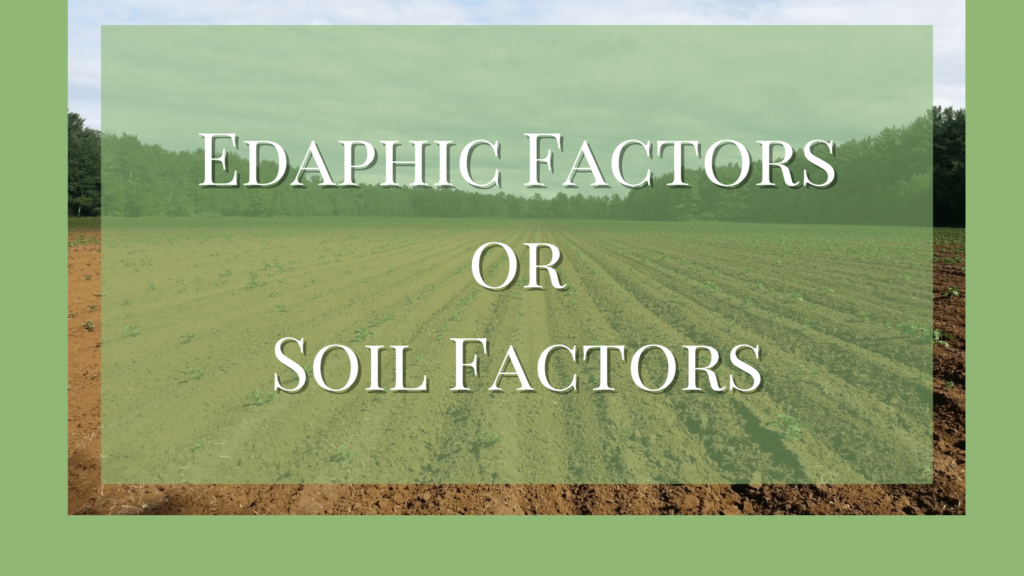Soil is the top cover of the earth in which plants can grow. It is a complex mass of both organic and inorganic matter, ie, it contains the weathered rock materials with decomposed organic matter derived from remains of plants and animals. They along with other physical and chemical matter together form edaphic factors.
What are Edaphic Factors?
Edaphic factors, also known as soil factors, refer to the characteristics and properties of soil that influence the growth and development of plants and other organisms. It includes factors that relate to the structure and composition of soil that have a substantial influence on the physiology of plants. Thus edaphic factors is a collective term referring to all types of chemical, physical, and biological characteristics of soil.
These factors play a crucial role in determining the suitability of an environment for various plant species. The constituents of the soil show great local qualitative and quantitative variation and constitute edaphic factors. These variations occur due to the discontinuity of the different edaphic factors involved.
Soil Profile
Soil is formed by the disintegration of rocky particles in a process called weathering. Disintegration is achieved through different agents like temperature, solvent action or water, wind, frost, etc.
Soil thus formed contains various components. The components of soil include organic and mineral matter, water, air, various chemical compounds, and microorganisms. The organic material in the soil is called humus which is the decomposition product of soil microorganisms.
The weathering action and the formation of humus are active in the superficial layers of soil while they are progressively lesser in the lower regions of the soil. Hence if a vertical section of soil (soil profile) is examined, there will be three different regions.
- The top region, ie, O horizon contains humus and this region is well suited for the growth of plants.
- The next region is the A horizon which has plenty of minerals to support the plant growth and a smaller amount of organic matter.
- E horizon is the next in line. This is not common in all types of soils. When present, this is the layer of leached particles such as clay, sand, silt, and organic and inorganic materials. It is common in forests and old soils.
- The next layer is the B horizon which is brown. The leached particles here arrive from the top two layers. The particles are closely packed and decomposing rocky materials are abundant. It also contains a greater amount of water and this layer pumps water to the top soil by capillary action.
- The next layer is the C horizon which contains practically the big rocky particles.
- The final layer is the R horizon, the bedrock. This layer contains parent materials such as granites, sandstone, quartz, basalt, and limestone.
Thus, a true soil sample contains organic and inorganic components having air and water. Some animals and plant microorganisms are always present in the soil. They greatly increase the fertility of the soil.
Edaphic factors affecting plant growth
Physical and chemical properties of soil influence the ecology as well as the growth of plants. Both extreme and minimal availabilities of these factors can greatly affect the plants, leading to their adaptations and thus the evolution of plants having unique characteristics.
Here are some key edaphic factors affecting plant growth are as follows.
- Soil Composition: The soil composition includes the proportions of sand, silt, clay, and organic matter. It affects soil fertility, water-holding capacity, and nutrient availability.
- Soil pH: pH level indicates the acidity or alkalinity of the soil. Different plants have varying pH requirements for optimal growth. pH affects nutrient availability and microbial activity in the soil.
- Soil Structure: The arrangement and aggregation of soil particles influence its porosity, permeability, and water-holding capacity. Soil structure affects root penetration, aeration, and drainage.
- Soil Moisture: The amount of water in the soil is crucial for plant growth. Soil moisture availability affects nutrient uptake, germination, and overall plant health.
- Soil Nutrients: Essential nutrients like nitrogen, phosphorus, potassium, and others are in the soil. Their availability and concentration impact plant growth and development.
- Soil Organic Matter: The organic matter in the soil influences its fertility, moisture retention, and nutrient-holding capacity. It supports microbial activity and nutrient recycling.
- Soil Microorganisms: Various microorganisms, including bacteria, fungi, and protozoa, reside in the soil. They contribute to nutrient cycling, decomposition, and disease suppression.
- Soil Temperature: Soil temperature affects microbial activity, nutrient availability, and plant metabolism. Different plants have specific temperature requirements for optimal growth.
- Soil Drainage: The ability of the soil to drain excess water affects plant root respiration and prevents waterlogging, which can be detrimental to plant health.
- Soil Erosion: The rate of soil erosion impacts soil fertility and stability. Erosion can result from wind, water, or human activities, leading to loss of topsoil and nutrient depletion.
Understanding and managing these edaphic factors are essential in agriculture, horticulture, and ecological restoration projects to create suitable growing conditions for plants and sustain healthy ecosystems.
Classification of Soil
Depending on the size of soil particles, soil can be divided into different types.
- Gravel (stones) -about 2 mm in diameter
- Coarse sand – 2-0.20 mm
- Fine sand – 0.20 – 0.02 mm
- Silt – 0.02 – 0.002 mm
- Clay – Below 0.002 mm
References
- Soil Horizons | Soils 4 Teachers. (n.d.). https://www.soils4teachers.org/soil-horizons/
- Rajakaruna, N., & Boyd, R. (2007). Edaphic Factor. Encyclopedia of Ecology, 1201-1207. https://doi.org/10.1016/B978-008045405-4.00484-5
- Shukla, R.S. and Chandel, P.S. (2001) Plant Ecology. S. Chand and Company Ltd., New Delhi.
- Verma, P.S., Agarwal, V.K. (1999). Cell Biology Genetics Molecular Biology Evolution and Ecology. New Delhi: S.Chand Co.(Pvt) Ltd.
Additional Reading
- What Are The Components Of Soil
- Edaphic Factors Affecting Plant Growth
- Different Types of Soil in India




